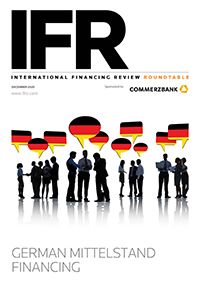IFR convened a call in October with a quartet of seasoned banking professionals on the outlook for Mittelstand financing in Germany, where we defined our corporate demographic as companies with turnover between €125m and €1bn. The focus of the discussion was on conditions and driving themes in the loan market.
The discussion kicked off by summarising where the market was at the end of 2019 and into the early part of 2020 before the pandemic took hold; described the conditions in the early phase of Covid-19 after much of the world went into lockdown; and had a stab at figuring out what 2021 might bring.
It’s easy to forget that pre-pandemic the loan market had been pretty constructive. There was a lot of activity, competition between banks was buoyant and acquisition financing was accompanying refinancing activity.
The events of February onwards are well documented: companies in the most affected industry sectors saw revenues plunge; industrial facilities were shut; supply chains broke down; the German government re-instituted the Kurzarbeit social insurance scheme; and KfW launched a series of corporate lending support schemes in parallel with other fiscal measures.
Companies instituted a desperate lurch for liquidity, immediately drawing on their back-up lines as they acted on first instincts to strengthen balance sheets as a precautionary measure. It was notable that neither the loan market nor the Schuldschein market shut during this panicky period. Loan tenors certainly shortened: five-year lines disappeared in favour of thee-year facilities with extension options, and utilisation fees went up.
For the banks, co-financing on KfW’s 037 Entrepreneur Loan programme (for smaller clients) and the 855 syndicated loan programme (for larger companies) was an attractive option as 80% of the risk is borne by the government.
In truth, the pandemic-induced period of market volatility and panic was short-lived. The twin impacts of massive fiscal and monetary support calmed markets. The sharp rise in risk premiums almost reverted to pre-pandemic levels relatively quickly. Many of the emergency lines that were drawn down were quickly refinanced, and the loan market by the start of the fourth quarter was returning to some semblance of normality.
While some banks did pull back out of caution, most maintained their engagement with borrowers and others used the period to put their balance sheets to work to greater effect. Risk tolerances didn’t necessarily go up, but by the same token, banks maintained existing tolerances, albeit there is a greater degree of risk differentiation that the long-run bull market in syndicated lending had erased.
Bank lenders are not complacent, however; speakers expressed a degree of caution about what happens when all of the loan moratoriums expire and the effects of economic recession start to bite. There are concerns about what happens to non-performing loans and corporate defaults, and whether the official support available in 2020 might have just kicked the can down the road.
That said, IFR’s panel was broadly upbeat, saying we could see the return of opportunistic refinancings as loan pricing settles down; better levels of M&A activity both by strategic and financial sponsors; busy general corporate-purpose borrowing by companies that postponed borrowing decisions this year; refinancing of liquidity lines; and companies taking up extension options.
To see the digital version of this report, please click here
To purchase printed copies or a PDF of this report, please email gloria.balbastro@refinitiv.com

